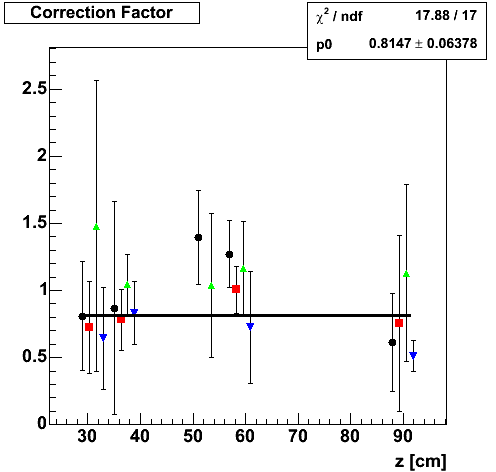TPC OmegaTau
Kinds of laser tracks used:
- Radial tracks: for Azimuthal (r*phi) OmegaTau Tensor Component Calibration
- Tangential tracks: for Radial OmegaTau (OmegaTauR) Calibration
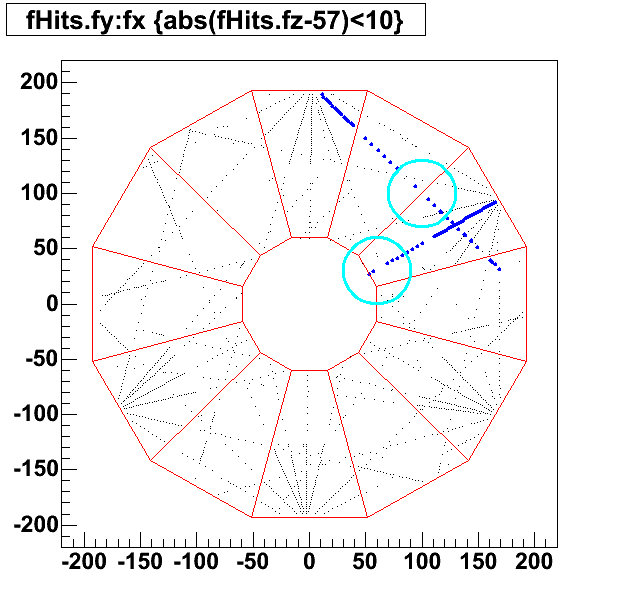
Azimuthal (r*phi) OmegaTau Tensor Component Calibration
Using lasers on the west end of the TPC, where there is no shorted ring, we have introduced distortions in the electric field by two methods: 1) adding extra resistance to the IFC resistor chain, and 2) altering the gating grid voltage. We collected data such that we have two reference (non-distorted) runs for the former, and four modifications (different gating grid voltages) for the latter (two of which have been used in this analysis)
For both of these techniques, we can compare the distorted laser tracks to the undistorted ones at the same location, and also to the corrected (using StMagUtilities code) versions of the distorted tracks. This allows us to determine how much we are under- or over-correcting the distortion for a given tensor component scale factor of OmegaTau (TV1). In this analysis, the initial value for TV1 used in the corrections is 1.34 (OmegaTau = ~2.76).
In the second section of this web page are plots showing fits to the amount of under- or over-correction seen for several laser beams from the different data sets. The amount of under- or over-correction is then used to determine what OmegaTau for that laser beam should be. One can then find the tensor component by solving the following equations for TV1:
Correction ~ OmegaTau / (1.0 + OmegaTau * OmegaTau)
OmegaTau = TV1 * (-10.0 * Bz * DV / (E / L))
where Bz is the z component of the BField, DV is the drift velocity, E is the potential difference between the central membrane and the gated grid, and L is the distance between the central membrane and the gated grid. The plot immediately below is a fit to the different values of TV1, using 7 laser beams at 4 different approximate z locations (~50cm, ~85cm, ~115cm, ~140cm), from 4 different datasets:
- Black circles = Resistor runs, 5063105 vs. 5063104 (in vs. out [normal])
- Red squares = Resistor runs, 5063105 vs. 5063106 (in vs. out [normal])
- Green triangles = Gating grid runs, 5022008 vs. 5022006 (-165V vs -115V [nominal)
- Blue inverted triangles = Gating grid runs, 5022010 vs. 5022006 (-65V vs -115V [nominal])
The different datasets are offset in z in the plot in order to make the points visible, but the same laser beam is used in each of the 4 datasets. The fit value of TV1 from this fit to these 7 laser beams is 1.37 +/- 0.02, resulting in values for OmegaTau of ~2.82 +/- 0.04. If only those laser beams at z less than 100cm are used, a value of 1.34 +/- 0.03 is obtained for TV1, or ~2.76 +/- 0.05 for OmegaTau. Other alternative fits, described at the bottom of this page, give results in the same range.
CONCLUSION: We should use a value of 1.36 +/- 0.03 for TV1.

The location z is measured as distance from the central membrane, with positive z in the west half of the TPC.
Individual laser beams:
The under- or over-correction is fit only out to radius of 120cm for two reasons: 1) for the resistor runs, the correction is small beyond this, and the relative error on the correction becomes large, and 2) for all runs, there are multiple laser beams converging at the outer radius of the TPC, causing overlapping hits. Outliers (under- or over-correction > 40%) are also removed from the fit (shown as red points in the lower of each plot pair).
In the above fit, I only used the TV1 values determined from the first 7 laser beams below. The last 5 below are all from large z, where the correction is small and the relative errors become large (the error on the hit location and laser beam stability becomes comparable to the correction size - this is clear in the above plot where the errors are already getting large at z of approximately 140cm). While multiple laser beams are from the same approximate z range, different z locations are used below to differentiate them (they are at different phi locations).
Also noticeable in the above plot is that the gating grid run datasets give TV1 values with larger errors than the resistor runs. This is again because the corrections are smaller for the gating grid runs, leading to a larger relative error in the correction. This is also why other gating grid runs, taken at intermediate voltages, were not used in this analysis.
It should also be noted that tracks at large z and small r in the TPC are outside most physics analyses.
As usual, in the upper of each plot pair, distorted laser points are in red, corrected are in blue, and the reference points are black.
| z \ runs | Resistor Runs | Gating Grid Runs | ||
|---|---|---|---|---|
| 5063105 vs. 5063104 | 5063105 vs. 5063106 | 5022008 vs. 5022006 | 5022010 vs. 5022006 | |
| 52 cm | 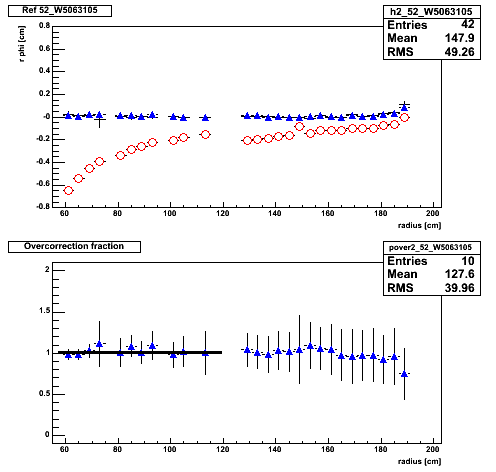 |
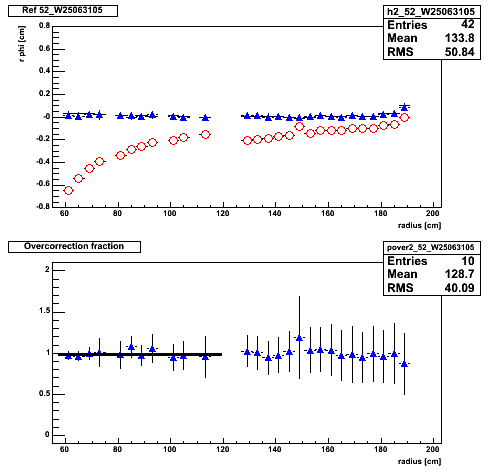 |
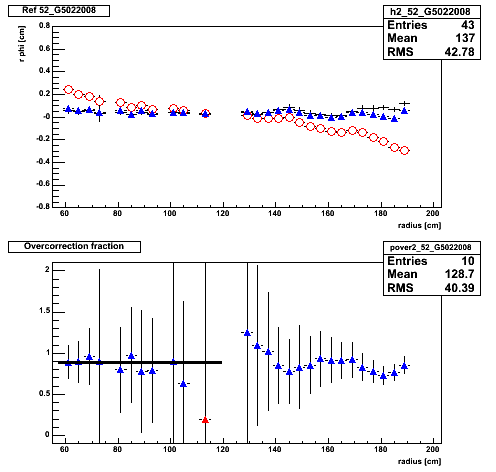 |
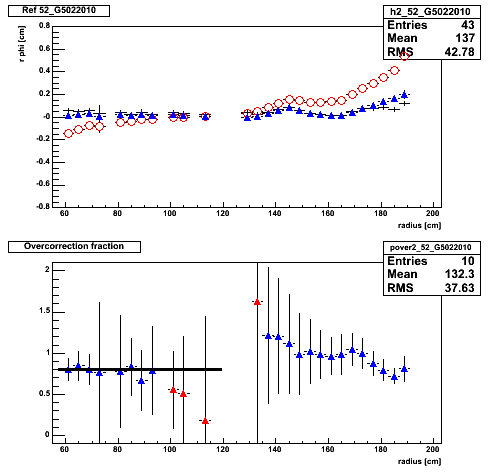 |
| 53 cm | 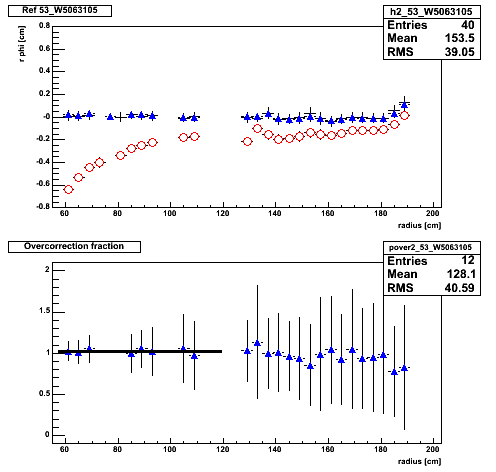 |
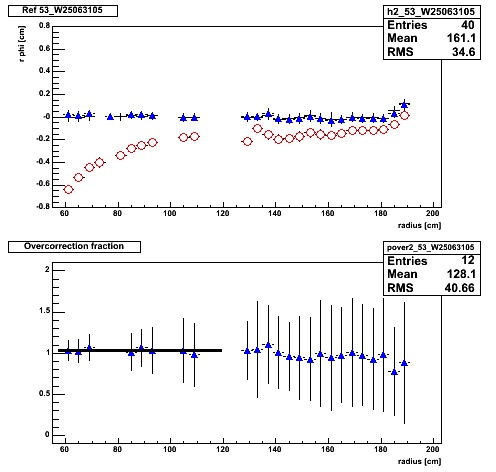 |
 |
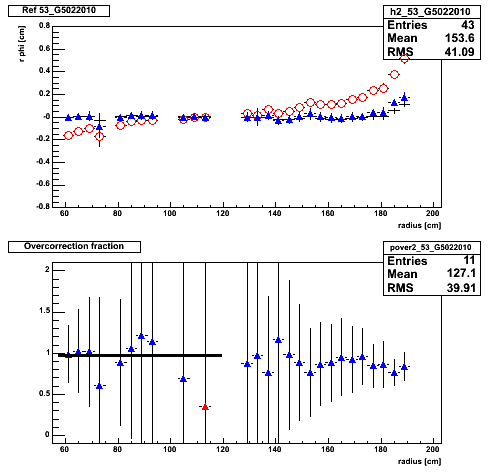 |
| 85 cm | 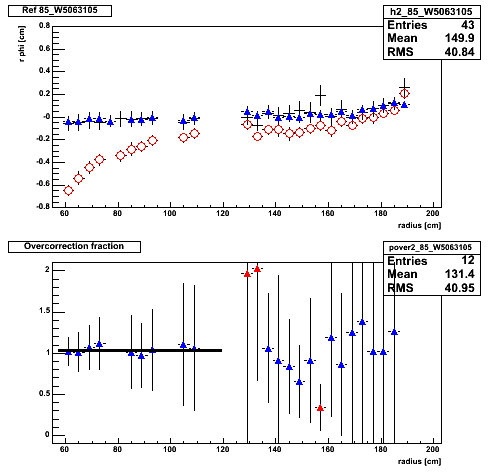 |
 |
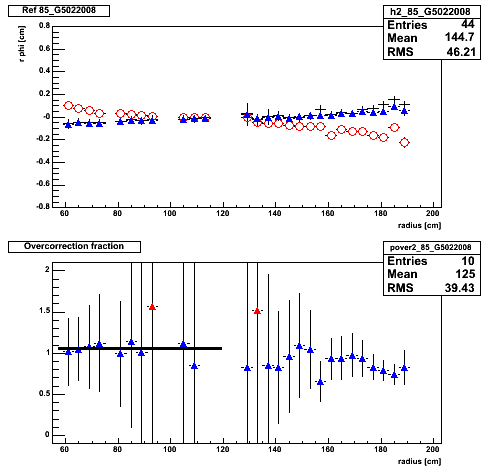 |
 |
| 86 cm | 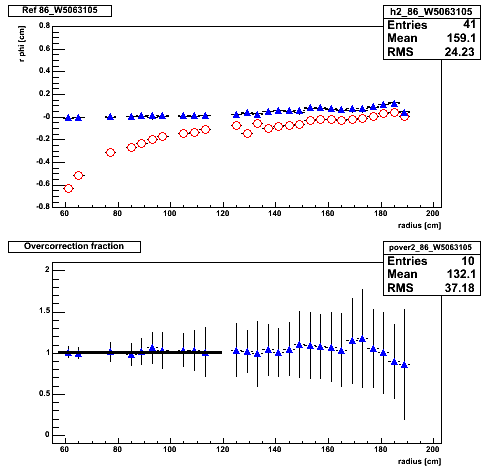 |
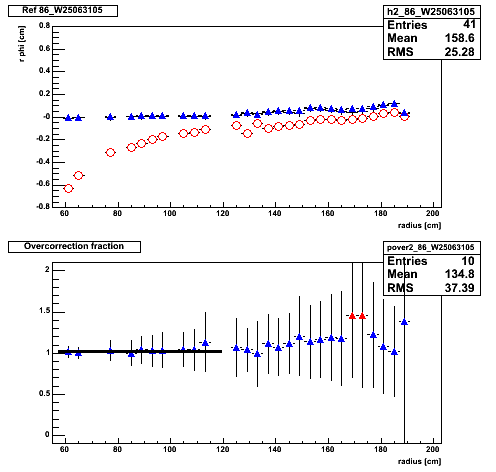 |
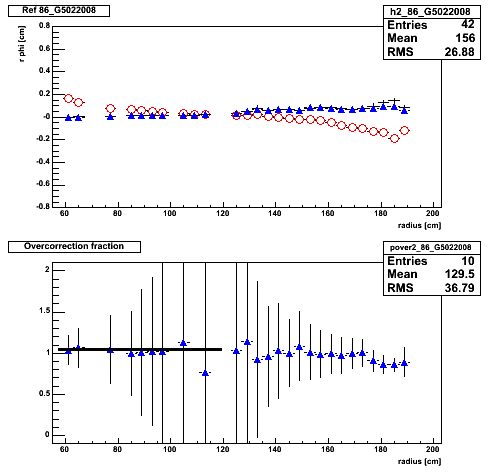 |
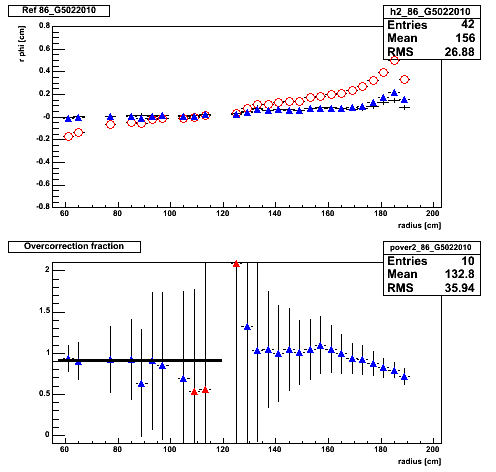 |
| 116 cm | 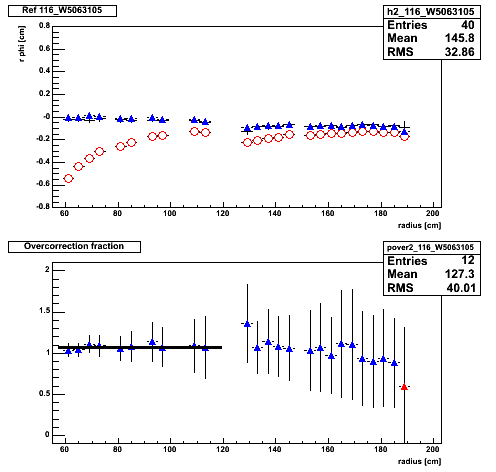 |
 |
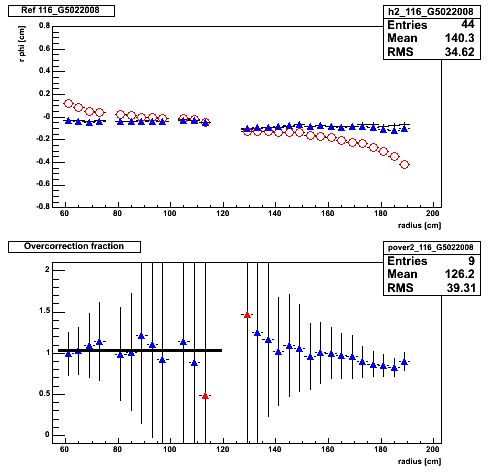 |
 |
| 140 cm | 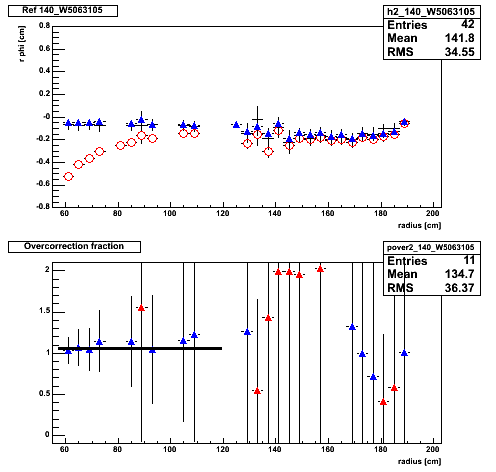 |
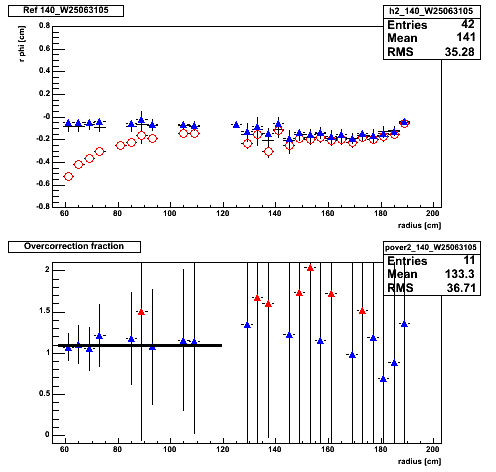 |
 |
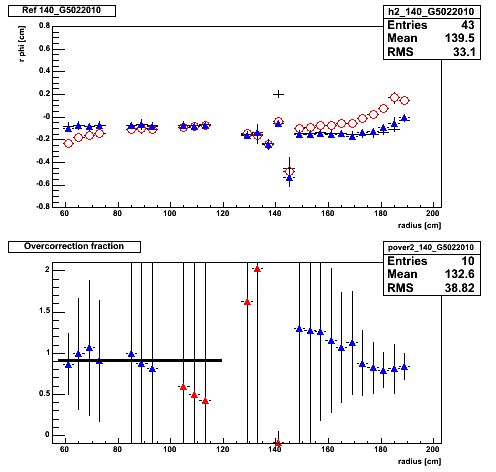 |
| 142 cm | 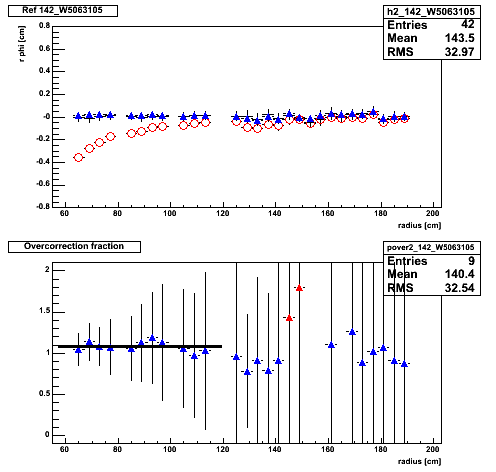 |
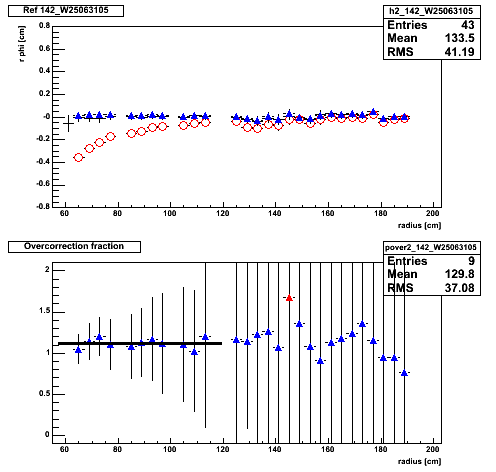 |
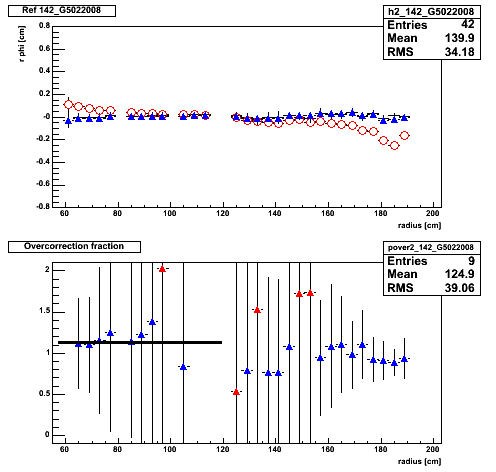 |
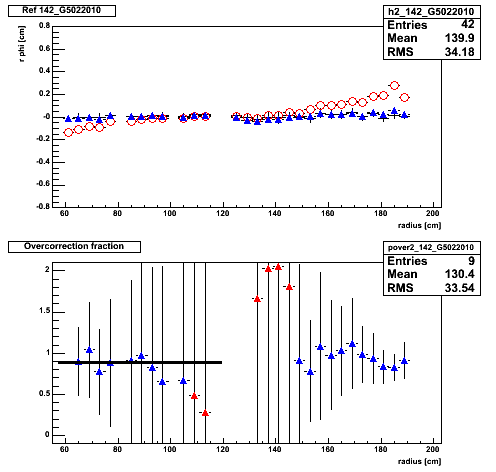 |
| 176 cm | 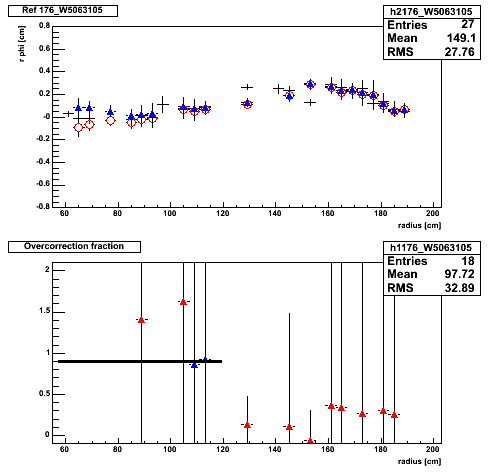 |
 |
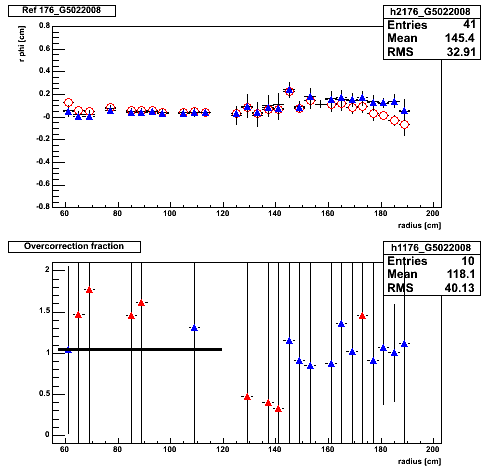 |
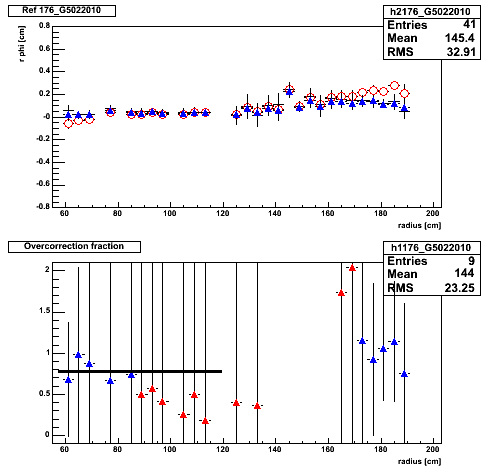 |
| 173 cm |  |
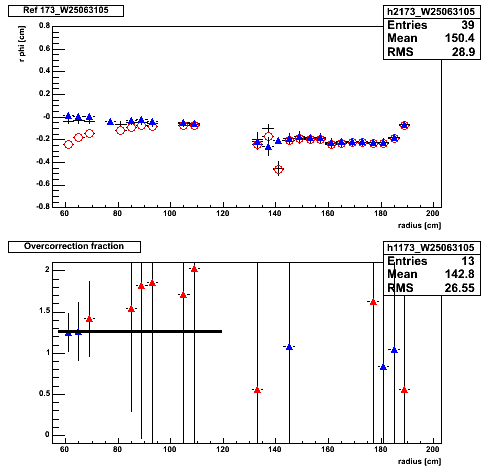 |
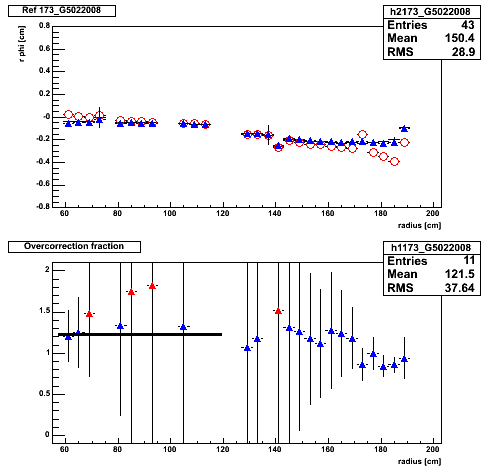 |
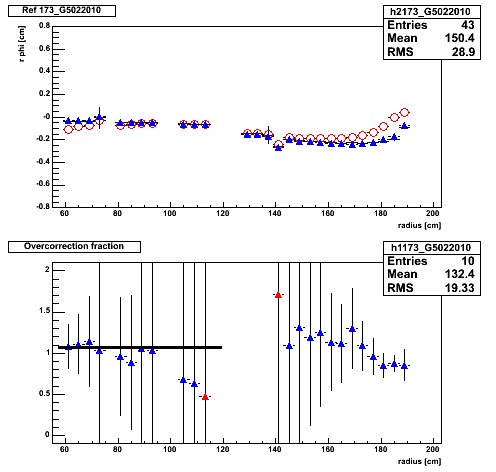 |
| 174 cm | 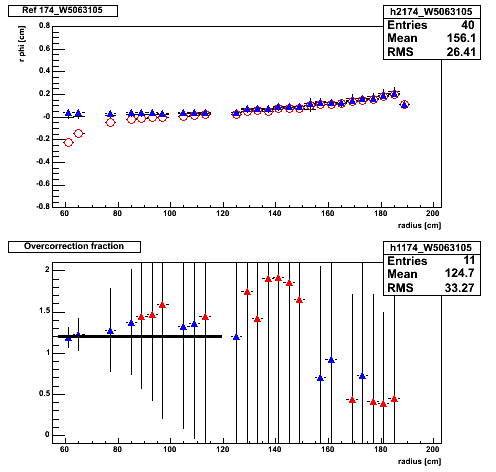 |
 |
 |
 |
| 175 cm | 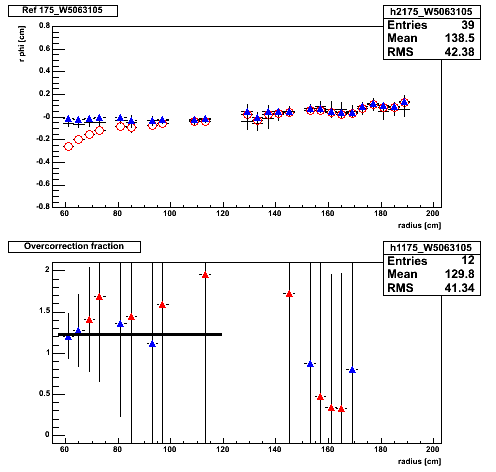 |
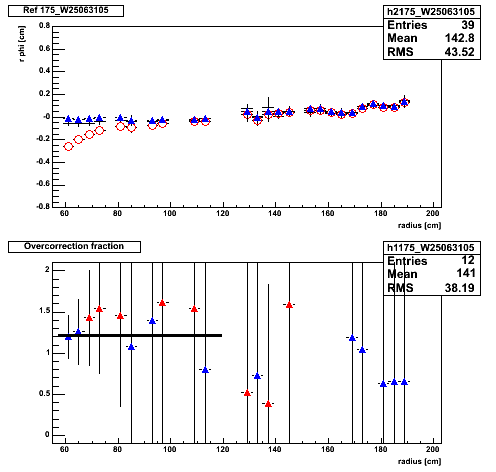 |
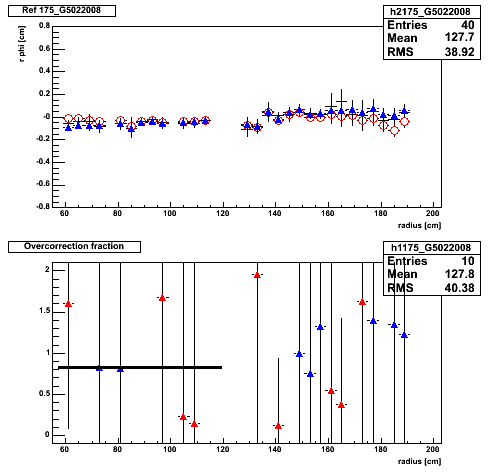 |
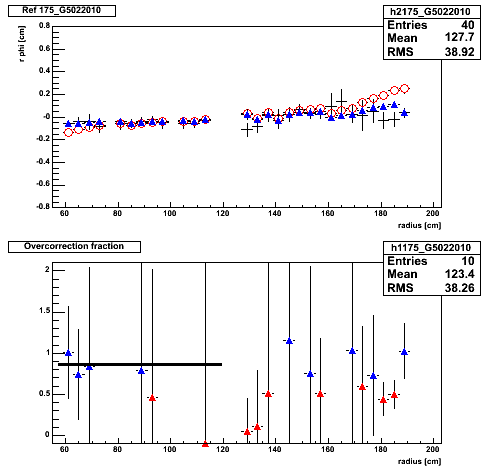 |
| 177 cm | 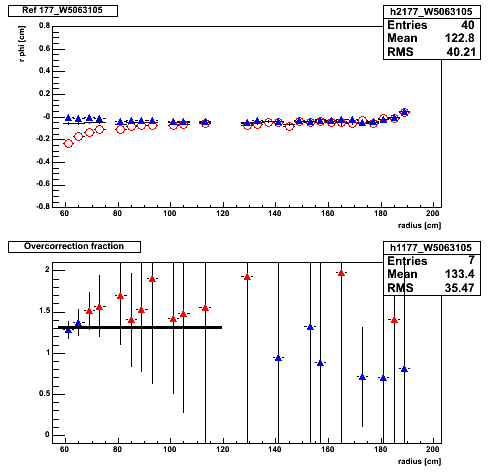 |
 |
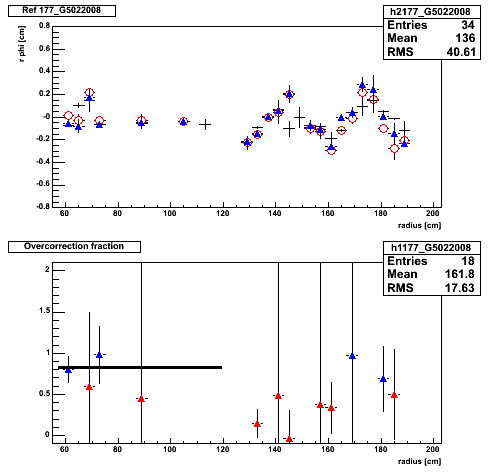 |
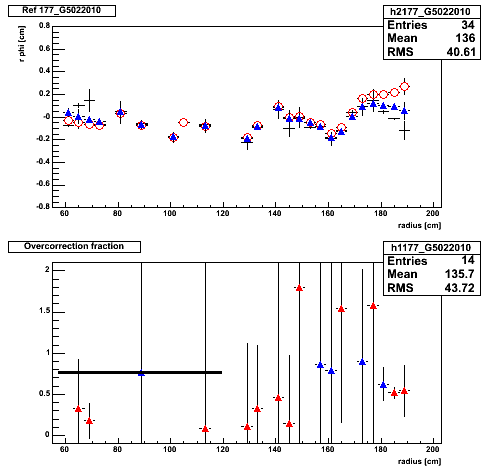 |
Alternate fits:
In addition to the fit described above for finding OmegaTau, a few alternative fits were used:
- Using an initial TV1 of 1.20 (OmegaTau = ~2.48) to process the data in the first place (insurance that the fit does not simply return something like what was used in the reconstruction) yields TV1 = 1.37 +/- 0.02 (OmegaTau = ~2.82 +/- 0.04).
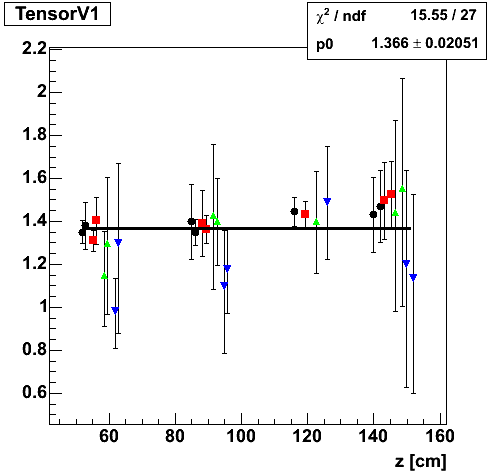
- Fitting all of the OmegaTau values from all lasers to determine one overall OmegaTau value, and then determining an approximate TV1 from that single new OmegaTau yields, for the two reconstructions using initial TV1 values of 1.34 and 1.20 (OmegaTau values of ~2.76 and ~2.48), OmegaTau = ~2.82 +/-0.04 for both analyses, and subsequently TV1 = ~1.37 +/- 0.02 and ~1.36 +/- 0.02.
Initial TV1 = 1.34:

Initial TV1 = 1.20:
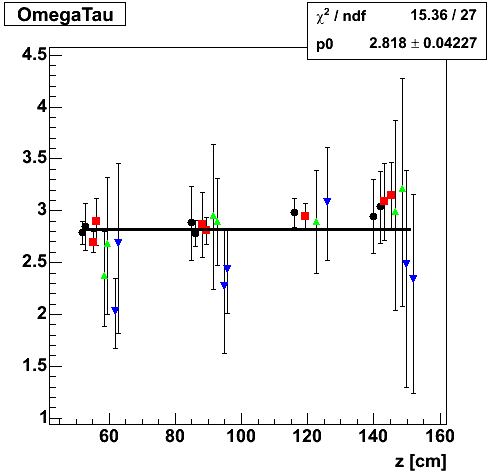
- Fitting all of the correction factors from all lasers to determine one overall correction factor, and then determining an approximate OmegaTau and TV1 from that single new correction factor yields, for the two reconstructions using initial TV1 values of 1.34 and 1.20 (OmegaTau values of ~2.76 and ~2.48), OmegaTau = ~2.82 +0.05 -0.04 and ~2.81 +0.05 -0.04, and subsequently TV1 = ~1.36 +/- 0.02 for both analyses.
Initial TV1 = 1.34:
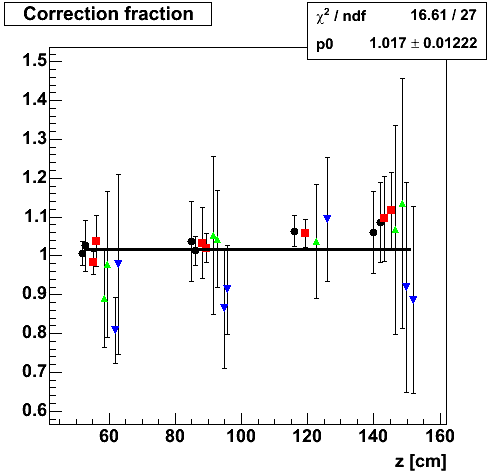
Initial TV1 = 1.20:

Radial OmegaTau (OmegaTauR) Calibration
Using lasers on the west end of the TPC, where there is no shorted ring, we have introduced distortions in the electric field by two methods: 1) adding extra resistance to the IFC resistor chain, and 2) altering the gating grid voltage. We collected data such that we have two reference (non-distorted) runs for the former, and four modifications (different gating grid voltages) for the latter (two of which have been used in this analysis)
For both of these techniques, we can compare the distorted laser tracks to the undistorted ones at the same location, and also to the corrected (using StMagUtilities code) versions of the distorted tracks. This allows us to determine how much we are under- or over-correcting the distortion for a given OmegaTauR. In this analysis, the initial value for OmegaTauR used in the corrections is 2.29.
At the bottom of this page are plots showing fits to the amount of under- or over-correction seen for several laser beams from the different data sets. The amount of under- or over-correction is then used to determine what OmegaTauR for that laser beam should be. The plot immediately below is a fit to those different OmegaTauRs, using 5 laser beams at 3 different approximate z locations (~30cm, ~50cm, ~85cm), from 4 different datasets:
- Black circles = Resistor runs, 5063105 vs. 5063104 (in vs. out [normal])
- Red squares = Resistor runs, 5063105 vs. 5063106 (in vs. out [normal])
- Green triangles = Gating grid runs, 5022008 vs. 5022006 (-165V vs -115V [nominal)
- Blue inverted triangles = Gating grid runs, 5022010 vs. 5022006 (-65V vs -115V [nominal])
The different datasets are offset in z in the plot in order to make the points visible, but the same laser beam is used in each of the 4 datasets. The final fit value of OmegaTauR using the 5 laser beams is 2.32 +/- 0.02.
CONCLUSION: We should use a value for OmegaTauR of 2.3.

The location z is measured as distance from the central membrane, with positive z in the west half of the TPC.
Individual laser beams:
The under- or over-correction is fit only for the first row or two of each laser in each sector as these are the only places where the laser is close to tangential. Shown in the plots below are the radius (relative to some arbitrary radial constant R0) as a function of padrow, where padrows 1-45 and 101-145 represent the two different sectors about the closest approach. Outliers (under- or over-correction > 55%) are also removed from the fit (shown as red points in the lower of each plot pair).
While multiple laser beams are from the same approximate z range, different z locations are used below to differentiate them (they are at different phi locations).
Also noticeable in the above plot is that the gating grid run datasets give OmegaTauR values with larger errors than the resistor runs. This is again because the corrections are smaller for the gating grid runs, leading to a larger relative error in the correction. This is also why other gating grid runs, taken at intermediate voltages, were not used in this analysis.
As usual, in the upper of each plot pair, distorted laser points are in red, corrected are in blue, and the reference points are black.
| z \ runs | Resistor Runs | Gating Grid Runs | ||
|---|---|---|---|---|
| 5063105 vs. 5063104 | 5063105 vs. 5063106 | 5022008 vs. 5022006 | 5022010 vs. 5022006 | |
| 29 cm | 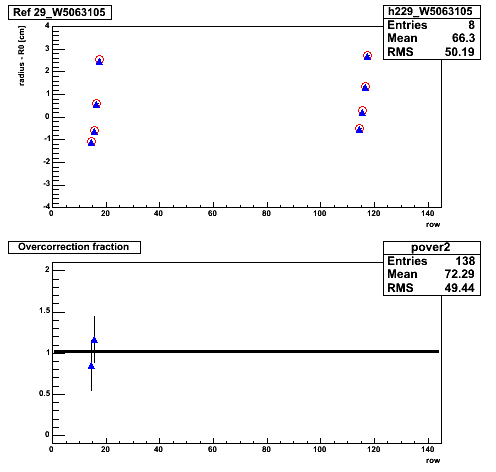 |
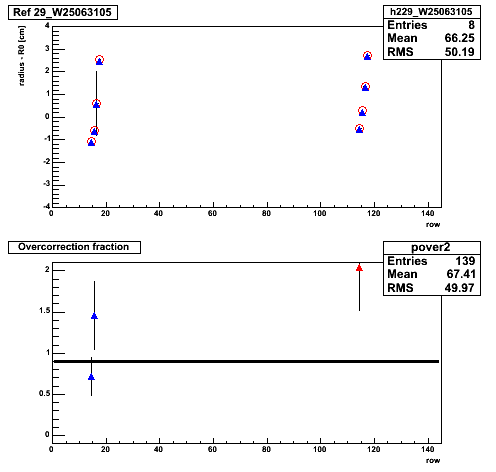 |
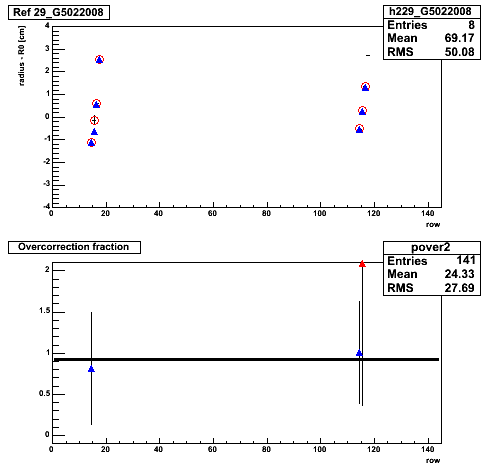 |
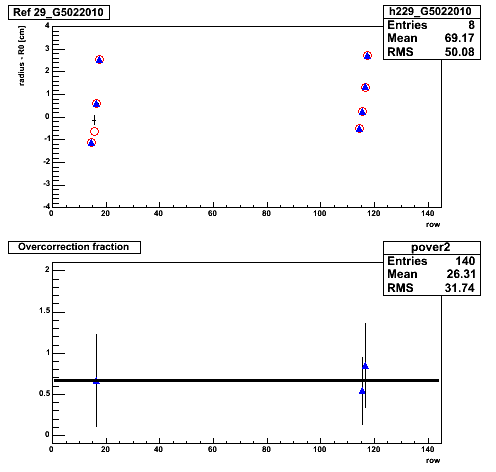 |
| 35 cm | 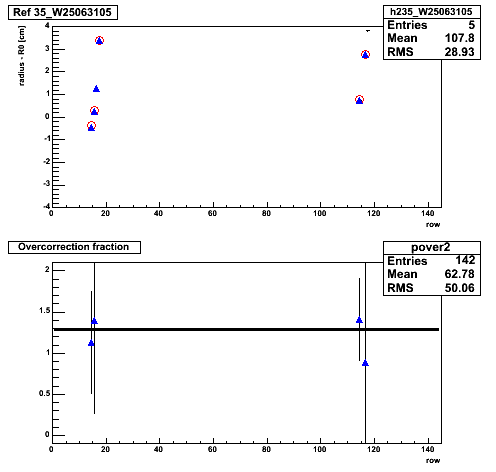 |
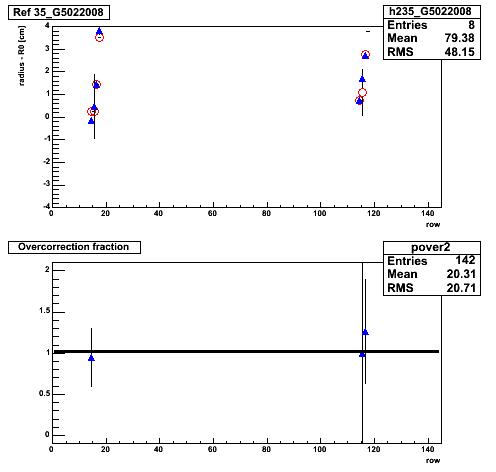 |
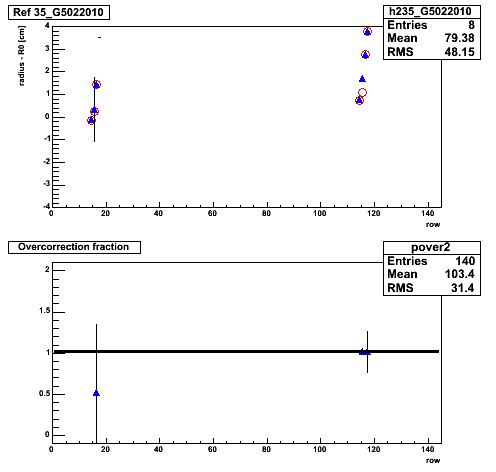 |
|
| 51 cm | 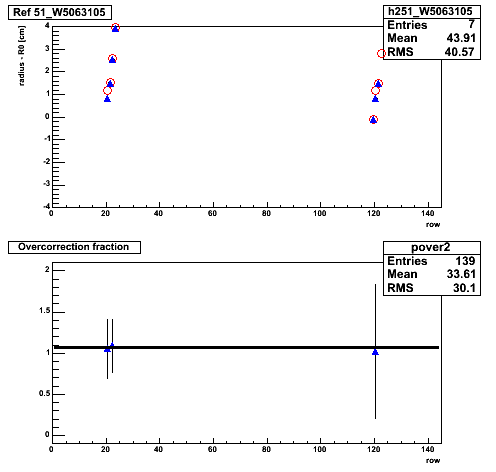 |
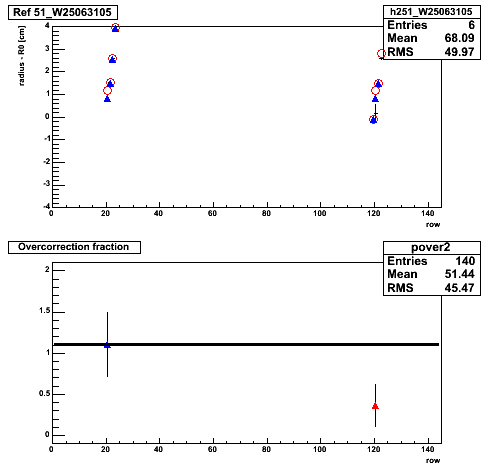 |
 |
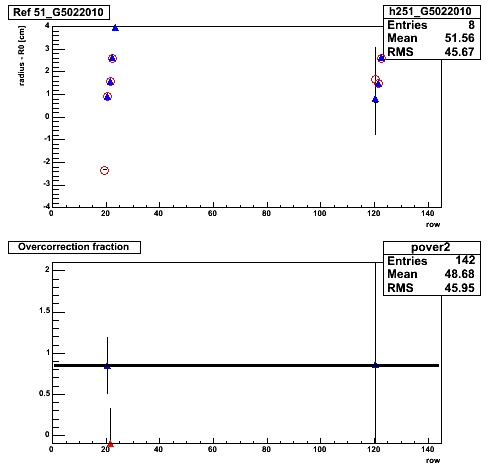 |
| 57 cm |  |
|||
| 88 cm |  |
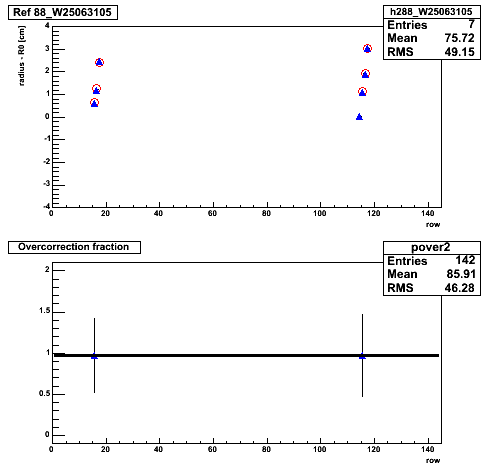 |
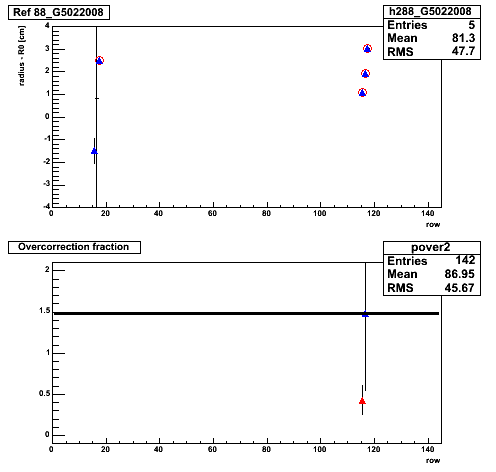 |
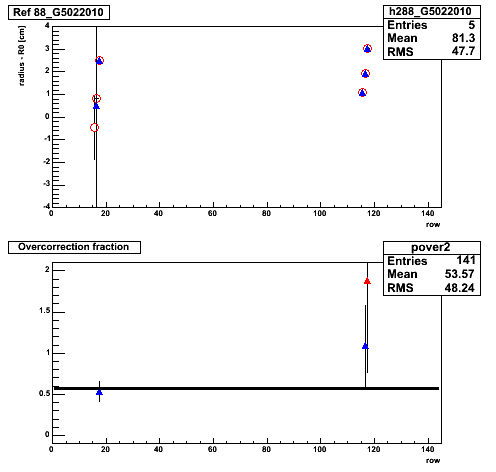 |
Alternate fits:
In addition to the fit described above for finding OmegaTauR, a few alternative fits were used:
- Using an initial OmegaTauR of 2.48 to process the data in the first place (insurance that the fit does not simply return something like what was used in the reconstruction) yields OmegaTauR = 2.42 +/- 0.11.
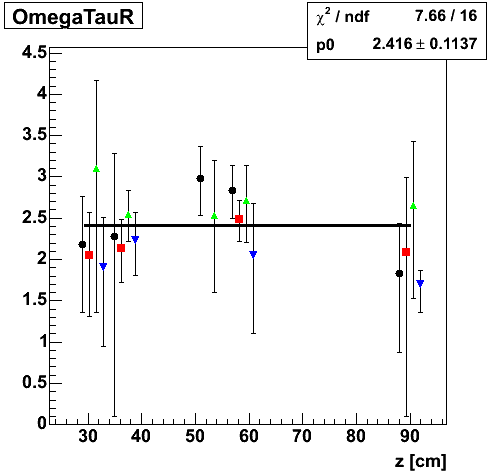
- Fitting all of the correction factors from all lasers to determine one overall correction factor, and then determining OmegaTauR from that single new correction factor yields, for the two reconstructions using initial OmegaTauR values of 2.29 and 2.48 respectively, OmegaTauR = 2.30 +0.02 -0.02, and OmegaTauR = 2.20 +0.10 -0.11.
Initial OmegaTauR = 2.76:

Initial OmegaTauR = 2.48:
